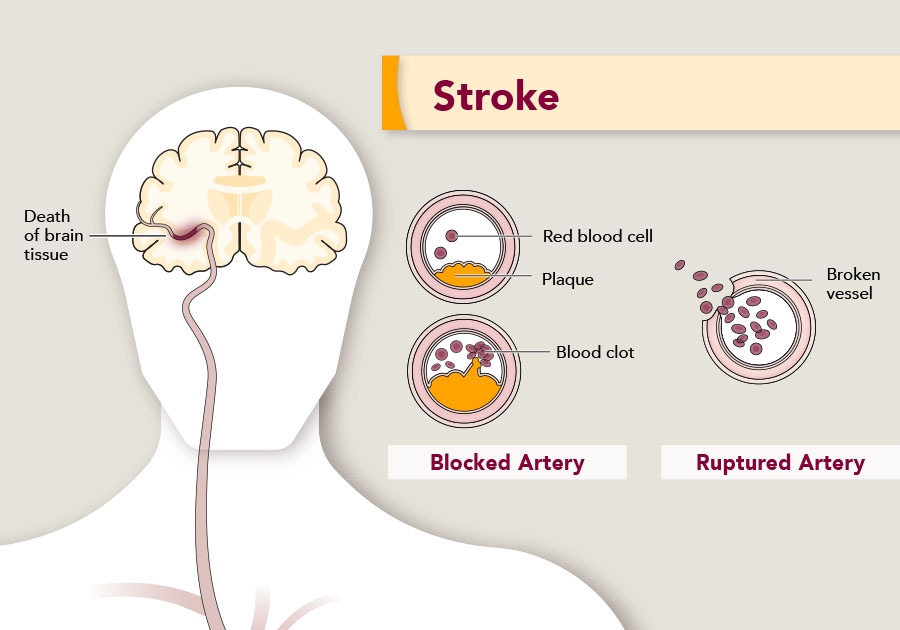Stroke kills nearly 150,000 of the 860,000 Americans who die of cardiovascular disease each year—that’s 1 in every 19 deaths from all causes.1
A stroke, sometimes called a brain attack, happens in one of two ways:
- Ischemic stroke—when the blood supply to the brain is blocked
- Hemorrhagic stroke—when a blood vessel in the brain bursts
A stroke causes brain tissue to die, which can lead to brain damage, disability, and death. Stroke is a leading cause of death in the United States and is a major cause of serious disability for adults. This is disturbing because about 80% of strokes are preventable.2
You can greatly reduce your risk for stroke by making lifestyle changes to help control your blood pressure and cholesterol levels and, in some cases, by taking medication.
Are you at risk for stroke?
A stroke happens in one of two ways. Click on the photo to learn more about artery blockages and ruptures.
Several factors that are beyond your control can increase your risk for stroke. These include your age, sex, and ethnicity. But there are many unhealthy habits, such as smoking, drinking too much alcohol, and not getting enough exercise, that you can change to lower your stroke risk.
Using tobacco products and having high blood pressure, high cholesterol, diabetes, or obesity can also increase your risk for stroke. However, treating these conditions can reduce your risk. Ask your doctor about preventing or treating these medical conditions.
What are the signs and symptoms of stroke?
An easy way to remember the most common signs of stroke and how to respond is with the acronym F.A.S.T.:
F = Face drooping: Ask the person to smile. Does one side droop?
A = Arm weakness: Ask the person to raise both arms. Does one arm drift downward?
S = Speech difficulty: Ask the person to repeat a simple sentence. Are the words slurred?
T = Time to call 9-1-1: If the person shows any of these signs, call 9-1-1 immediately. Stroke treatment can begin in the ambulance.
- Sudden dizziness, trouble walking, or loss of balance or coordination
- Sudden trouble seeing in one or both eyes
- Sudden severe headache with no known cause
- Sudden numbness of the face, arm, or leg
- Sudden confusion or trouble understanding others
If you think that you or someone you know is having a stroke, call 9-1-1 immediately. Stroke is a medical emergency, and stroke treatment and outcomes depend on how fast you get to the hospital and the type of stroke the person had.
When you are transported by ambulance, first responders may be able to start your treatment right away and can alert the hospital that a stroke patient is on the way. This notification gives the hospital’s medical team time to prepare equipment and medicines you may need.
How is stroke diagnosed?
Your doctor can perform several tests to diagnose stroke, such as brain imaging, including a magnetic resonance imaging (MRI) or computed tomography (CT) scan, tests of the brain’s electrical activity, and blood flow tests.
Can stroke be prevented?
High blood pressure is the single most important treatable risk factor for stroke. Preventing, diagnosing, and controlling it through lifestyle changes and medicine are critical to reducing stroke risks. There are several steps you can take to reduce your risk for stroke:
- Eat a healthy diet low in sodium with plenty of fruits and vegetables. Tips on nutrition are available at CDC’s Division of Nutrition, Physical Activity, and Obesity
- Maintain a healthy weight. CDC’s Healthy Weight website includes information and tools to help you lose weight.
- Be physically active. Visit CDC’s Physical Activity website for more information on being active.
- Don’t smoke, and avoid secondhand smoke. CDC’s Office on Smoking and Health website has information on quitting smoking.
- Limit alcohol use. See CDC’s Alcohol and Public Health website for more information.
- Prevent or manage your other health conditions, especially high blood pressure, high cholesterol, diabetes, and obesity. Visit CDC’s High Blood Pressure, Cholesterol, and Diabetes webpages on these conditions to learn more.
How is stroke treated?
If you have a stroke, you may receive emergency care, treatment to prevent another stroke, rehabilitation to help you relearn the skills you may have lost because of the stroke, or all three. In addition, lifestyle changes, such as the ones listed above, can help lower your risk for future strokes. Talk with your doctor about the best ways to reduce your stroke risk, and always take medicines as prescribed.
For More Information
Learn more about stroke at the following websites:
- CDC’s Division for Heart Disease and Stroke Prevention
- Paul Coverdell National Acute Stroke Program
- Million Hearts®external icon
- CDC Vital Signs report: Preventing Stroke Deaths
- American Stroke Associationexternal icon
- National Institute of Neurological Disorders and Stroke, Mind Your Risks®campaignexternal icon
References
- Centers for Disease Control and Prevention, National Center for Health Statistics. Underlying Cause of Death 1999–2017 on CDC WONDER Online Database website. http://wonder.cdc.gov/ucd-icd10.html. Accessed January 7, 2019.
- Lackland DT, Roccella EJ, Deutsch AF, et al. ; American Heart Association Stroke Council; Council on Cardiovascular and Stroke Nursing; Council on Quality of Care and Outcomes Research; Council on Functional Genomics and Translational Biology. Factors influencing the decline in stroke mortality: a statement from the American Heart Association/American Stroke Association. Stroke 2014;45:315–53.
- Benjamin EJ, Muntner P, Alonso A, et al. Heart disease and stroke statistics—2019 update: a report from the American Heart Association. Circulation. 2019;139:e1–e473. doi: 10.1161/CIR.0000000000000659.
https://www.cdc.gov/stroke/facts_stroke.htm


